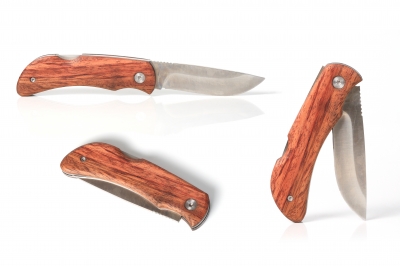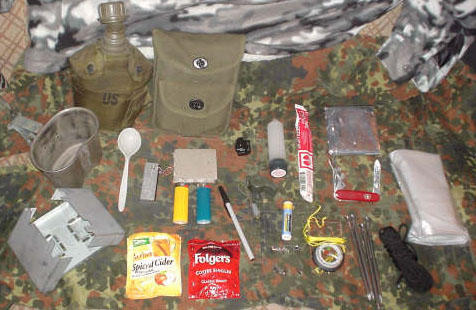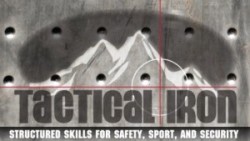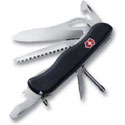First off, what is Every Day Carry? Everyday carry (EDC) is the lifestyle of being prepared. Having a survival kit or first aid kit at home or in the car is preparedness. But having a kit on you during your entire day is in reality, the lifestyle of being prepared. Lifestyle is the “way you live”. Not a hobby or a form of brief entertainment. For instance, you may know someone who dabbles with the guitar. But then there are folks like Jimi Hendrix who became one with the guitar, and really embodied the term “guitarist”. Hendrix played the guitar everyday. When he didn’t have one, he pretended. He was known to sleep next to his guitar. In the Army, he kept one close by. He spent the short life he lived playing more and accomplishing a level unattainable by most. Those who carry an EDC kit are the real life true practitioners of the Art of Survival and embody the term “preparedness”.
What is an EDC kit? The term “kit” is deceptive. The EDC includes the clothes you wear, the shoes, the jacket and even your accoutrements. The philosophy of EDC is to have everything on you that ensures your protection from the elements, hazards, and other people. This includes disasters, severe weather, extreme terrain, physical conflict and also providing basic needs like shelter, food, water and the ability to communicate. You don’t have to look like a Bedouin or a SWAT team member. Part of the concept is that you blend in, not giving away the treasure trove of useful tools and equipment on your person for others to steal, envy or attempt to rely on. You want to appear, as you really are, an average person who is prepared to meet the challenges of any given day. You do not want to look like Rambo, Indiana Jones or the Terminator. But think of yourself more like a MacGyver or a Batman while in perfect disguise. You can use the hidden tools at hand to ensure your survival, and the people that you love or care about too by keeping yourself in safe condition.
What about when I’m jogging, or out on a date, or even at work? The lifestyle of being prepared is about ALWAYS being prepared.
You can compromise intelligently based on your activity. Wear a suit or skirt and heels to work? You can still have a small lighter, key chain flashlight, and pocketknife in your purse or pocket. Not to mention the bounty of space offered in a briefcase, laptop bag, or business tote. An executive without a cell phone is almost unheard of these days. A cell phone allows you to communicate with co-workers, friends, and loved ones. It carries personal information, some have cameras to record events, and in emergencies you can call in the police or the EMT. It allows you to get up to date information, co-ordinate, and in some cases they have a built-in tracking device to use to find a persons location. In this sense, a Laptop or pad is also an excellent investment for the ability to store information, provide detailed news or research, and communicate with allies. Nowadays, a laptop case is the ultimate urban camouflage. They can carry a jacket, water bottle, extra shoes, flashlight, handgun, first aid kit, and lunch to boot. What about while exercising? You can carry a lot without looking like it. When training you can carry a folding knife with a clip and carry it in your waistband. You can strap a tiny MP3 player to your arm. A bandana around your head or in your pocket can be used as a bandage, dust mask, or weapon.
Your clothing can be functional as well. Windbreaker, trail running shoes, loose fitting top and pants are excellent to fight, evade, and blend into the crowd with. Appearing to be non-threatening is important during a crisis like a robbery, assault, or dispute. Blending in is very important so that you are not assumed to be the antagonist, hero, scumbag, or excellent choice for a kidnapping or hostage situation. The quality of your clothing is more important than the brand name. Too expensive a style of clothing pinpoints you as being wealthy and too poor as a homeless person desperate for valuables or drugs. Try to appear as an average, working person who belongs in the city or locale that you are in. Be it Calcutta or Houston. Most of all, buy clothing that performs its function. A jacket that actually insulates, stops water, and protects from the wind is vital. Shoes that breathe, keep your feet warm and dry, provide traction and protect you from blisters are probably the most vital part of your kit. The simplest form of travel is walking. It is free, quiet, and during major disasters most likely will be your main source of travel. You should be able to run, jump, kick, and walk long distances with your shoes. There are even ways to lace your shoes that will assist you. Using para cord as shoelaces gives you another tool for survival. Paracord is a nylon high test-strength rope used for parachutes.
It is known to be very tough for its thickness, and handy like duct tape. You can find many colors, and can even lace in a hidden compass, razor blade, or P-38 can opener. You can also lace your shoes or boots in such a manner that they are quick to cut off in case you need to swim or ditch your footwear. Does this seem too extreme or too expensive? Remember, survival is your lifestyle, not your hobby.
As you begin to consider the clothing, and items that you carry every day, you become informed of the possibilities and functions of them. This is a natural byproduct of the lifestyle, and a happy one at that. You can be more fully aware of the things that you purchase, use items to their fullest potential and see things as having many uses. You become more of a recycler of goods. Not that you would horde trash, but actually that you need less as you learn that most things have more than one use. A belt can be used as a tourniquet, rope, weapon, strap, equipment carrier, tree climbing device, and if it is strong enough, as a belay or seat for rappelling or as a towrope. An excellent example of this is the character in the movie “Castaway”. He is the only survivor of a plane ditched in the ocean. The character manages to arrive on a small island after being adrift on a lifeboat. He only has what is on his person, and what he can recover from a few packages from the plane, and later from a dead pilot that he finds half submerged in the water on the beach. He uses an ice skate, plastic door, boat oar, and even local plant life to affect his eventual rescue. In most situations, scavenging from stuff lying in the street or the dead will be at the least a social stigma and at most considered looting and can cause your death. Therefore, having the basic essentials on your person is a huge advantage. Putting care and thought into your EDC is something that can save your money, family, and life in the long run.
Your kit should not be limited to items that only appear to be everyday. Some items are very specialized and cannot be made to appear innocuous. Firearms, compasses, water filters, and tools aren’t considered everyday items to the average person. However carrying items inside bags, pockets, in ordinary looking belongings, or hidden will prevent embarrassing or life threatening situations. Carrying a firearm concealed should only follow the laws in your area. Carrying a firearm illegally does you and your family no good if it is discovered at a roadblock, after a dispute, while talking with law enforcement or rescue personnel, in a verbal disagreement, during disaster evacuation, or if it is used to defend yourself then later it is used against you in a lawsuit. Also, knowing how to safely carry, fire, unload, load and holster a firearm is essential. Negligent discharges are deadly. So carry your firearm legally, and get training. There is an incredible amount of ways to carry firearms concealed. Do some research, and spend some money. Comfort, retention, accessibility, actual concealment, reliability and wear are the things to consider. Also, carry a reload for your weapon. Redundancy is not bad in survival situations. Having items that do overlapping jobs or having a spare item is great practice as you can equip an ally or stash it for later retrieval. Spare items can be sold or traded. In emergencies, items can be overlooked, left behind, broken, fail or even be stolen. Having multiple methods as back up in the military is called a fail safe. Basically, there is say one computer that does a job. Then there is also a back up that kicks in. Finally, if the back up fails there is a tertiary measure such as a third computer that will kick in. You don’t have to carry 3 firearms, or 3 knives, but 3 lighters or forms of currency, or three forms of identification won’t weigh you down. Also having three friends to contact in an emergency isn’t bad. Remember, having too much gear will mark you as a target or slow you down during travel or evacuation. Sometimes you must carry a loved one, extra gear or just move quickly so keeping your kit light is high on your priority list.
This brings us to how you carry your items. As mentioned earlier, a tote or purse is great. However, if you have 2 seconds to jump out a door or over a fence, these can be left behind. Part of the EDC system is that you carry everything on your person, without extra backpacks, or bags. One retailer specifically makes non-military looking vests and jackets that appear completely unremarkable. Amazingly, they have up to thirty pockets including pockets for electronics, water bottles, and identification. Another method is to carry ultra light and miniaturized equipment so that the impact of carrying a kit is minimized. Micro LED key chain flashlights, micro multi-tools, mini Bic lighters, small flip cell phones, and “baby” or “micro” handguns such as snub-nosed revolvers and automatics in the smaller calibers. Yet another method is to purchase items that do more than one task. Flashlight/pens, belt w/hidden cash compartment, belt buckle knives, key chains with built in devices, cell phones with camera, day planner, audio recorder and flashlight, and combo signaling devices such as whistles with built in match holder, flint, and compass. These items are commonly available at stores such as Sharper Image, Wal-Mart, army surplus stores, camping stores, and knife shops or gun shops. Don’t forget to look at do-it-yourself solutions. Fanny packs, passport pouches, bra wallets, and other travel pouches make excellent everyday carriers for your gear. Even ace-type bandages, baggy clothes, and medical tape can be used if necessary. The more you can fit is not as important as it appearing that you are not carrying extra or out of the ordinary equipment. Try to maintain your personal style, work dress code requirements, and what is appropriate for different occasions. A relative seeing a bowie knife under your shirt, or a boss seeing a gun strapped to your ankle is more than just embarrassing. Be creative, and enjoy this aspect of EDC. It is challenging and fun, as you compete with others awareness. Children are very good at spotting out of the ordinary things, and are not usually afraid to mention it so use them as a tool but also, be wary.
Lastly, on carrying your kit, be sure to carry items in a fashion that allows you to function. You want the items to maintain their integrity, and stay on your person as well. Make sure items are secure. Can you crawl, run, jump, lay prone, roll, climb, and walk quickly without sounding like a toolbox and without losing all your gear? Test your carry method for concealment, retention, and integrity. Also make sure items do not rub you raw or cause reactions or even injure you. When you test your carry first do everyday tasks around the house. See if it changes your walking pattern or noticeably shifts your clothes independently of your movement. This is a sign your kit is too heavy or bulky. As you sit, lie down, and lean make sure items aren’t becoming exposed, slipping, or even falling out. All of these issues must be addressed before you go to the next level. Next, go to the store and do some shopping or go to the park. Do things that require bending, taking long steps, and dealing with the public. Make sure that your kit is secure and undetectable. Even if your kit is somewhat detectable under close scrutiny, this is better than an obvious kit exposed to all. Wear different types of clothing, and jackets. Wear summer clothing, and go for a walk or jog. Lastly, you want to do an extreme test. Go play paintball with your kit. Go play some touch football, or a game of basketball. Make a sort of obstacle course in your yard or at the park. You want to make sure your kit is intact. If you are trying to crawl under a fence, or sneak down a staircase you do not want objects falling out and clattering or hanging up and snagging you to other objects.
In an extreme situation you could be climbing trees, taking cover under objects, jumping fences, running, wading through water, swimming, hiking steep hills, or picking your way through broken glass. You could be dealing with flood, fire, explosion, riot, tornado, rainstorm, blizzard or total darkness. You may be carrying extra gear, injured personnel, pets, or you may be boarding up widows, or digging trenches or stacking heavy equipment. You may be pulling yourself out of a car wreck, or building collapse. These scenarios are not intended to frighten you, only to give you a way to plan your kit for carry and item selection. It is a mandatory aspect of EDC that you test the way you carry your kit. It shows you what is important, reveals weaknesses in your system, and keeps you constantly aware of your EDC kit. Keep in mind that your kit will be exposed to many extreme elements, so you should plan for that accordingly. Purchase or use items that are robust, water resistant, and consider spare batteries for your electronics. Batteries should not be exposed to water or heat. One resource to keep electronics and batteries dry is the cheap zip-lock bag method. You can also use condoms, or waterproof tape. Pelican makes high quality waterproof boxes that are small and break resistant plastic. Prepare your clothing as well. Be aware that some clothing tears easily, and some materials do not dry quickly or melt fast when applied to heat. Some natural materials are excellent for your EDC. Wool is recommended, as it is resistant to most elements, and even when wet provides some insulation. Leather is tough, and can be waterproofed quite easily. Both are somewhat fire resistant. Man-made materials like Gore-Tex dry quickly, stops wind and water, and are fairly resistant to wear. Whatever your clothing choices, be sure to keep clothes in good repair and mend then regularly. Boots and shoes should be polished or waterproofed as needed.
EDC kits become smaller over time, and you begin to adapt to having the extra gear on your person. It is nice having a small flashlight and pocketknife as many know, but having a needle and thread in your wallet is a lifesaver if you rip your pants on the way to work or a button falls off your blouse. Also, as you learn about items doing multiple jobs you discover that fishing line, for instance, makes great floss, thread, and tripwires. Or that having a small magnet can hide a key, retrieve dropped keys, or just keep notes paperwork from falling as you work under the hood of your car. You will enjoy the self-confidence and feelings of self-reliance as you go, and possibly those around you will appreciate your handy presence, and take note. Offered in closing are some words of advice, and also a list of suggested items that have worked well for your peers who also live the EDC lifestyle.
Pocket knife– Make sure the knife is lightweight but strong, and easy to get to fast. Brands that offer written warranty are the best. Save your money, and buy one good quality knife. Then buy more inexpensive back-ups. One good knife can last a lifetime. Clean, oil, and sharpen your knife to maintain its usefulness. Ceramic and titanium both have benefits, but more common steel blades are easy to bend back into shape or expediently sharpen in the field.
Flashlight-With LED type flashlights available, why get anything else? The bulbs burn brighter, last longer, and save battery life. Also, you can use rechargeable batteries and carry spares, as well as use solar, vehicle (12 Volt) or regular wall outlets to charge them. Many of the LED flashlights are shockproof inherently, and water resistant.
Wrist Watch-Most watches of good quality already have all the features one would hope for. The watchband is fairly important, as you want a material that will be strong, and not wear quickly. There are some watches out there that offer panic buttons that tie in with your alarms system, heart rate monitors, radios, TV, and other goodies. Usually, you can buy a wrist compass that attaches to the watchband, but check these for quality.
Multi-Tools-This is definitely a category where you get more bang for your buck. Most choose to carry a full size multi-tool as they are more reliable, and capable of doing the jobs one would use them for. However, they can get quite heavy. Some tools come with a nice black finish that is non-reflective. If you decide to carry one in a pocket, consider a dummy cord or leash lanyard. Real Swiss army knives are great multi-tools as well.
Dust Mask-Paper dust masks come in many varieties. Most will fold up, and can be carried in a back pocket. Bandanas, handkerchiefs, and balaclavas are good too. Most dust masks use an elastic band, so be careful if you have an allergy to this material.
Cash-Try to carry many denominations of cash and coins. If you live near a border to another country, carry their cash too, as well as your passport. Coin purses are great to silence coins, and prevent their loss and they are great to stash other gear too. Hide your cash on your person, using a secret place, such as a money belt or ankle pouch.
Laser Pointer-Amazingly useful for signaling, testing for smoke, and for pointing or “painting” far away objects. Do not point them directly into the eyes of anyone.
Condom-Useful to waterproof gear, carry water, or “hide” valuables. Package has to remain intact however, and this is difficult. Be aware of expiration date. Non-lubed is better for multiple uses.
Tiny Can Opener-If you opt to not carry a multi-tool or Swiss army type knife; you really need one of these. Military P-38 can opener can fit on your key chain and really works. A regular knife can open a can, but it dulls on a steel can quickly.
Large Needle-A heavy gauge sewing needle is great in ones wallet or belt pouch. It is easy to find makeshift thread, but really difficult to find a makeshift needle. Great for taking out splinters, sewing, lancing blisters, scrapping tools, or as a weapon.
Bic Lighter-So cheap, reliable, lightweight, and small that there is no excuse not to carry two. Zippo type lighters or butane lighters are great but require a lot of maintenance. They are also heavy and expensive. Another item that is very useful is the pocket torch. Pocket torches are available at hardware stores, hobby stores and at stores such as Radio Shack. However, these could be considered drug paraphernalia in some states.
D Carabiner-Another great overlooked item for your kit. These are so incredibly useful and strong that they are almost mandatory. They can be used to secure gear, carry keys, stash items, and of course as connective devices. Go to a climbing supply store and purchase a real carabiner, with weight ratings. Don’t go for the dime store copies.
Permanent Marker-Some of these markers write on almost any surface, and don’t wash off. Many types and colors are available. Great for marking property, leaving messages, writing notes (even on skin!), and marking a trail. Most will write on metal and glass.
Belt-Usually the workhorse of carrying all your gear. Also can be purchased as a money belt with hidden compartment. Buy real leather or strong nylon. Cheap is very bad. Some belts will take buckles of different types, and many buckles are made that conceal useful gear and weapons. Be careful of your local laws when considering a weapon.
Slim Signaling Mirror-Can be obtained at sporting goods, and backpacking stores. All metal is better for strength. Mirrors offer a multitude of uses, but are often a pain to carry.
Magnifying Glass-Do some research on this item. Some fit in your wallet and are actually shaped as to focus light to start emergency fires. There are many types, however. Some fit on key chains, or are used to examine jewelry, and some are made of plastic rather than glass.
Pocket Radio– MP3 players and smart phones fall into this area. Some offer TV, short wave, AM/FM, emergency band, and the like. Some can be solar charged, hand pumped (to charge battery), or work on small batteries. Headphones are nice to listen to the radio in quiet, and constantly monitor news stations live. There are many phone Apps that offer many preparedness options: compass, police scanner, weather forecasts, etc.
Sunglasses/Safety Glasses-Protective eyewear is a must. Only purchase quality, proven brands. Find glasses that protect from UV/UB rays, impact, and still allow good peripheral vision. Find glasses that fit your head snug, and consider carrying prescription glasses as well. Oakley is a very good brand for EDC.
Medications-Carry your medications in a waterproof container at all times. Carry at least, a three-day supply. Keep cycling the pills around so fresh pills are inserted periodically. Carry a card in your wallet describing your medical condition. Consider writing directions on dosage, in case you are unable to dose your medication yourself.
Copyright 2006 by duracles. Reprint permission granted provided the article stays intact.






















Recent Comments